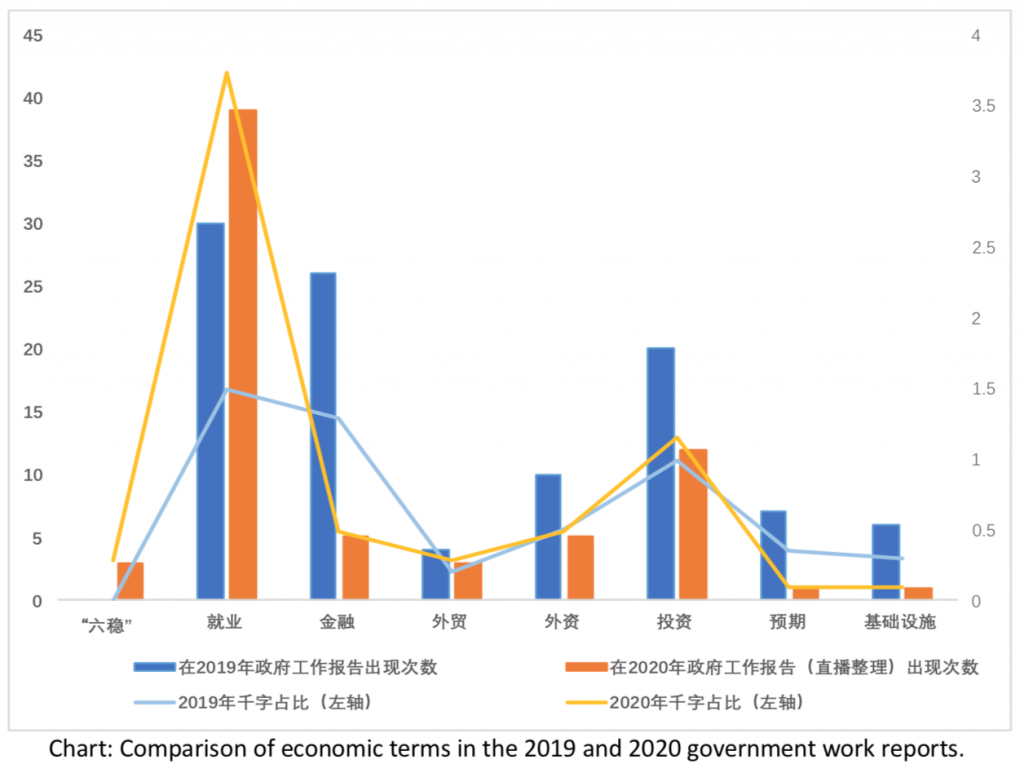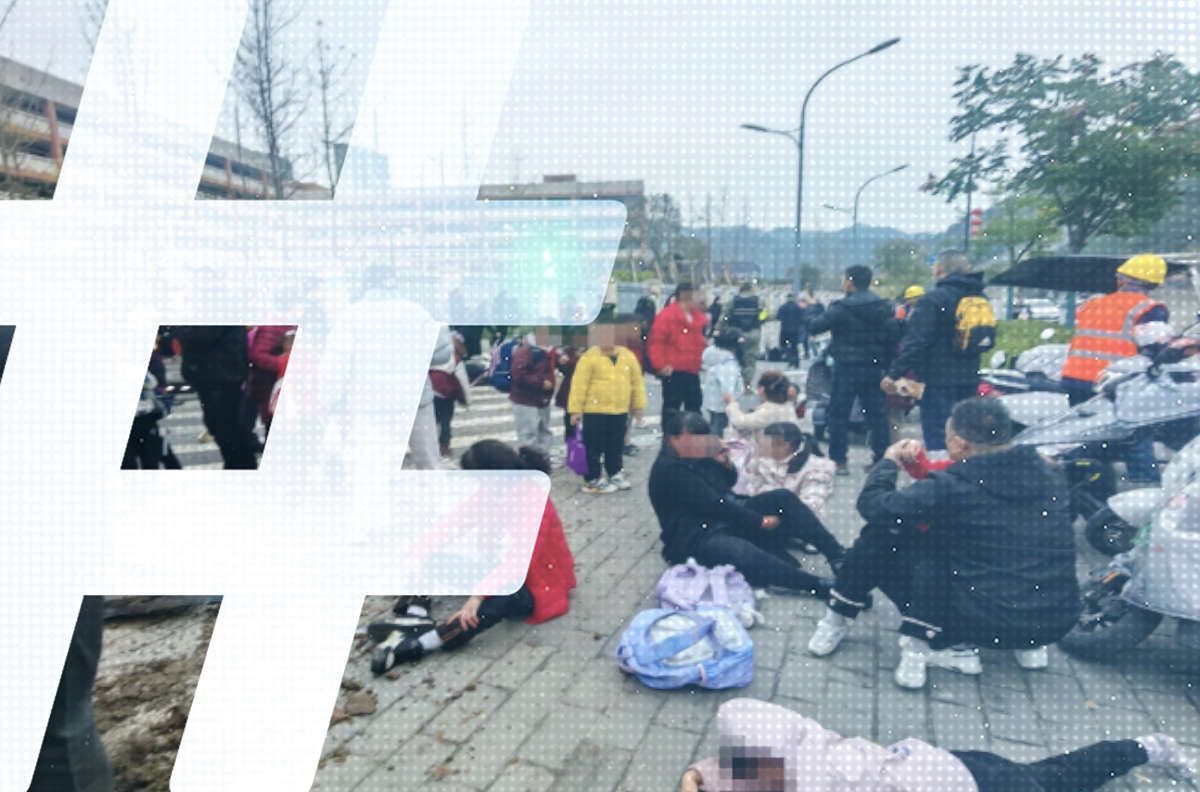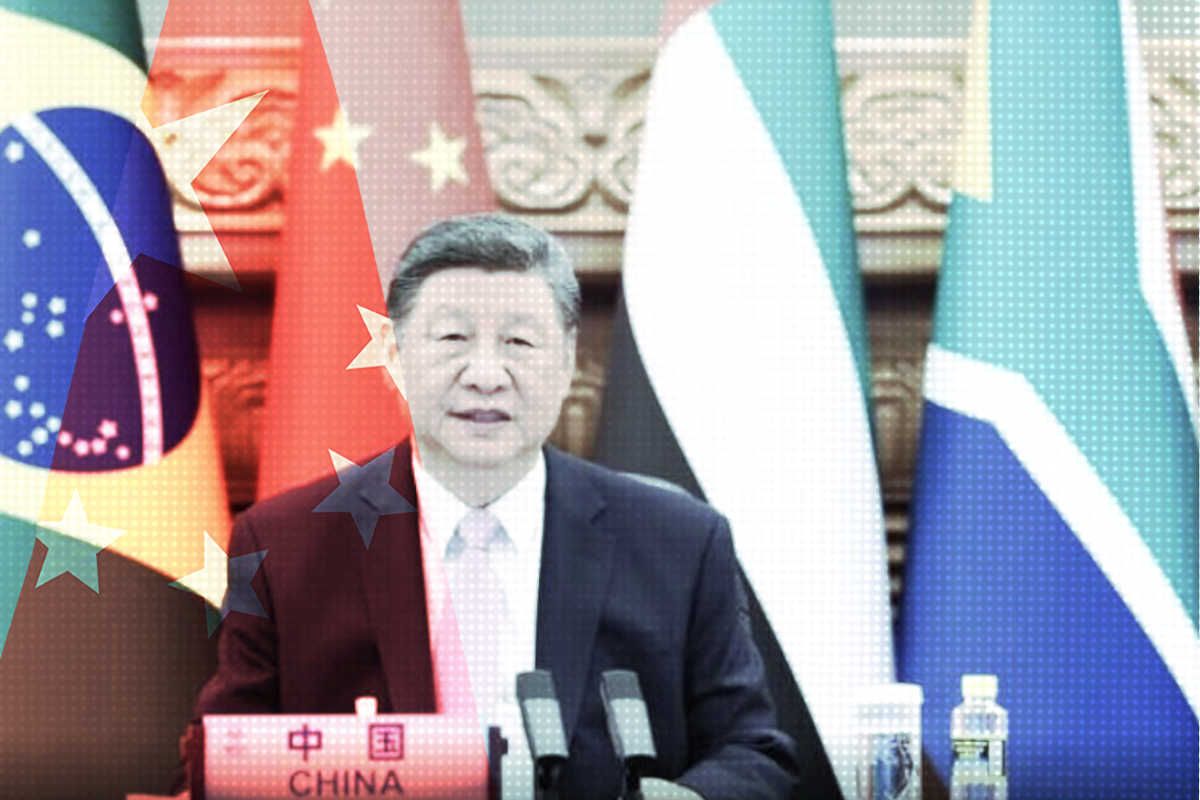Headlines and Hashtags
At the NPC: Xi Jinping, Hong Kong and Jobs
The “two meetings” of the National People’s Congress (NPC) and the Chinese People’s Political Consultative Conference (CPPCC) have been shortened in 2020, and correspondingly the government work report delivered by Premier Li Keqiang (李克强) has been cut down, from last year’s more than 20,000 characters to just 10,400 characters. Li’s address on Friday took just one hour to deliver, short by historical standards.
But as the room for verbiage was halved in this government report, what terms and priorities were emphasized?
No decline whatsoever in terms such as “core” signifying Xi Jinping’s power
In the 2020 report, like the 2019 report, we find the so-called “442 formula,” referring to the “Four Consciousnesses” (四个意识), the “Four Confidences” (四个自信) and the “Two Protections” (两个维护), appearing once. The phrase group, which is an important indicator of Xi Jinping’s central role in the CCP leadership, was briefly absent from the texts emerging in February and March from meetings of the Standing Committee of the CCP Politburo, the Communist Party’s highest decision-making body – possibly a sign that drum-beating over Xi’s status was being toned down somewhat in the midst of the coronavirus epidemic. But the “442 Formula” quickly returned, and seeing it in the work report is perhaps a further sign of the return to normal in terms of bullish treatment of Xi and his leadership.
In the 2019 government work report, Xi Jinping’s name appeared 13 times, and Xi’s banner term, “Xi Jinping Thought on Socialism with Chinese Characteristics for the New Era” (习近平新时代中国特色社会主义思想), appeared four times. It is important to note that even as the text of the work report was chopped in half this year, we had just one less instance of Xi’s name, and one less instance of his banner term. If we look at the use of both in terms of use per 1,000 characters, the rise in volume in the 2020 report is clear.
Nevertheless, despite its very strong appearance in the work report, “Xi Thought” (习思想) has not yet been further elevated by the inclusion of the phrase “raising high” (高举). We do not yet have the phrase, in other words, “raising high the banner of Xi Jinping Thought on Socialism with Chinese Characteristics for the New Era,” which would indicate a new climb in status for Xi as paramount leader.
At the tail end of the report, we can clearly see a point where the graduated phrase might easily fit. But the report reads instead: “. . . raising high the banner of Socialism with Chinese Characteristics, with Xi Jinping Thought on Socialism with Chinese Characteristics for the New Era as the guide” (高举中国特色社会主义伟大旗帜,以习近平新时代中国特色社会主义思想为指导”).
The following table compares the occurrence of various key terms in the 2019 and 2020 government work reports, as well as the lengths of the reports and relevant sections:

Like the 2019 report, this year’s report does not use a number of the more boastful terms (自嗨语) that can readily be found in the state media to describe China’s strengths and its importance globally. Terms like “China Model” (中国模式), “China Plan” (中国方案), “Chinese knowledge” (中国智慧) and “Chinese template” (中国范本) are not present, nor is the term “great power responsibility” (大国担当), a foreign policy phrase that seems to have appeared more frequently in recent months to describe China’s actions globally in the midst of the Covid-19 crisis.
However, we can spot another phrase, related to the above, that has also played prominently of late in the official media – “political and institutional advantages” (政治和制度优势).
The phrase “national security” (国家安全) appears twice in both the 2019 and the 2020 work reports.
A greater emphasis on “employment”
In the 2019 work report, the now common phrase “Six Stabilities” (六稳) had not yet emerged. However, there was mention at two different points in the 2019 report of “stabilities” outside of this rhetorical formula. These are: stable employment (稳就业), stable finance (稳金融), stable foreign trade (稳外贸), stable foreign investment (稳外资), stable investment (稳投资) and stable expectations (稳预期). The terms “Six Stabilities” and “Six Guarantees” (六保) – 1) employment, 2) basic livelihoods, 3) the market structure, 4) grain and energy security, 5) industry supply chains, and 6) operations at the grassroots – have now become formalized in 2020 as part of the official discourse, and we see each of these appearing 3 times in the government work report this year. Aside from these mentions, there are 39 separate mentions of “employment” (就业) alone, 9 more than last year (again, in a report just half the length). This suggests that within consideration of the whole range of economic issues, maintaining employment is one area that particularly concerns the government.
The grimness of the employment situation and the extreme challenges facing enterprises as they struggle to survive can be glimpsed in other areas of the work report this year, such as the dropping of GDP targets, talk of raising the intensity of efforts to lower taxes and fees (加大减税降费力度), promoting the lowering of operating costs for enterprises (降低企业生产经营成本), and talk of “doing everything possible to stabilize and expand employment” (千方百计稳定和扩大就业).

Hong Kong, Taiwan and the US-China relationship
When we compare the People’s Daily front-pages in 2019 and 2020 announcing the government work report, we can see obvious similarities. But there is also an obvious point of difference that has to be noted, and this concerns the issue of Hong Kong, which is raised in a subhead: “Hearing the draft of the Civil Code and the draft decision of the National People’s Congress on the establishment and improvement of the legal system and enforcement mechanism of the Hong Kong Special Administrative Region to safeguard national security.”

Judging from the text of this year’s government work report, within the context of what are relatively brief and simple remarks on the relationships with Hong Kong and Taiwan, and with the United States, there is a much more severe treatment of Hong Kong. No longer do we see, as in the 2019 report and previous reports, language about “offering full support to the SAR governments and chief executives of Hong Kong and Macau in accordance with law.”
The chart below compares the statements in the 2019 and 2020 government work reports on the question of Hong Kong, Macau and Taiwan.

To sum up, this year’s government work report maintains a tone toward the leader (领袖) of vowing loyalty and devotion, while it strikes a more realistic and practical tone on the relative economic difficulties facing the country. On Hong Kong, meanwhile, the tone of the work report suggests a clear change from last year’s “two meetings,” which came after the proposal by the Hong Kong government in February 2019 of the extradition bill, but before the onset of successive months of protests in June 2019. As these issues in the report are deliberated this week, we can expect to see these characteristics play out further.
NOTE: This article used the version of the text of the government work report as presented at the NPC, not subsequent versions appearing online, which may differ slightly.
[Featured image: Protesters gather in Hong Kong in July 2019 to oppose the proposed extradition bill. Image by Studio Incendo, available at Flickr.com under CC license.]




















